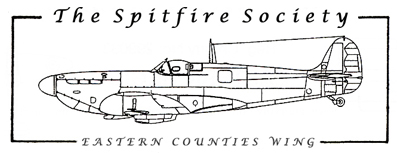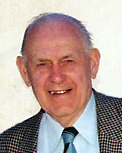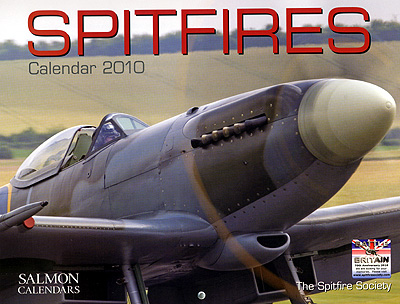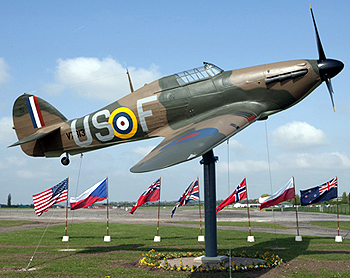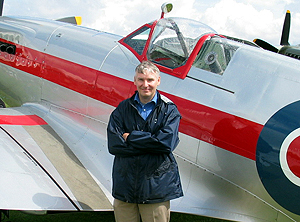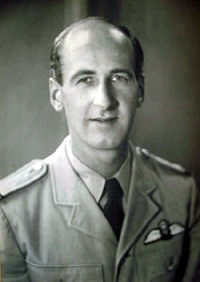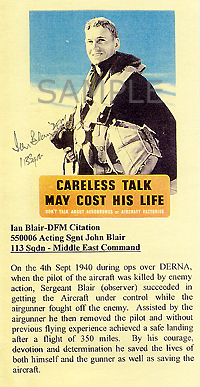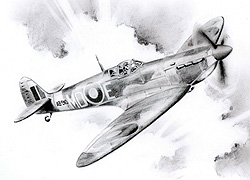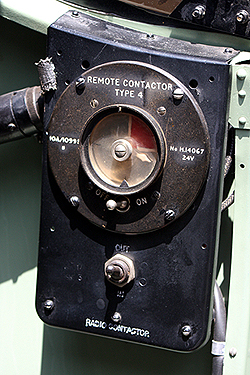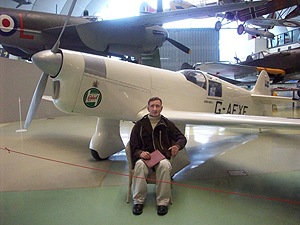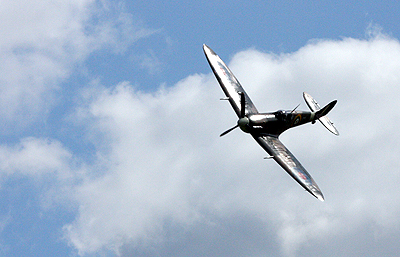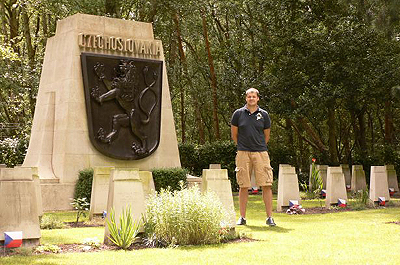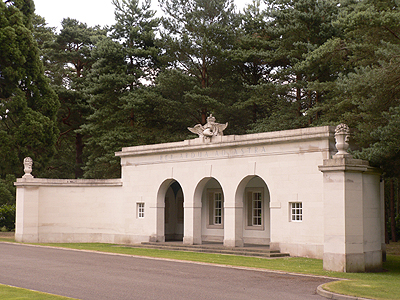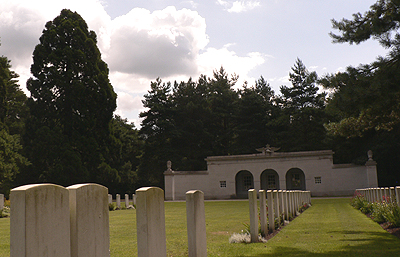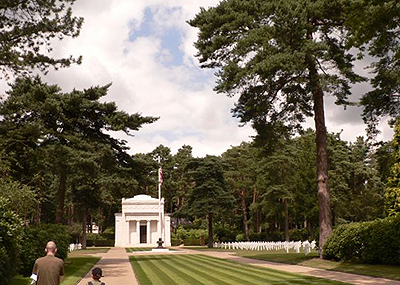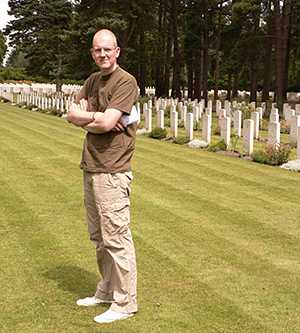 Home Page
Pat Butler
|
INDEX
The Memoirs of Reg Skolfield - Part
5
Liaison Officer United States Army (UK)
Pip Squeak and The Remote Contactor
Commemoration of The Battle of Britain
----------
Having just celebrated its twenty-fifth
Birthday, the Spitfire Society faces up to a very challenging
twenty-sixth. The demise of the old ten regions system has led
to the introduction of just two, the Eastern Counties Wing and
the Western Counties Wing. We are of course the Eastern Counties
Wing and our territory will stretch from the Scottish border
down to and including the Isle of Wight.
It gives me great pleasure to extend to every
member in the new wing a very sincere and warm welcome. Where
there are a group of members living fairly close together, I
hope it will be possible to form a Spitfire Roundels Club.
The May Air Show at Duxford was very
successful and, by the time you read this, I hope the Flying
Legends Show will also have proved to be a great success. The
Spitfire Day is on the 9th of August, with other Air
Shows on the 5th and 6th of September and
11th of October.
We are in dire need of members to help at
these Air Shows.
May I wish you all good health and a
pleasurable summer.
David
----------------------------------- Welcome to Form 700 This is
the first edition of the Form 700 Newsletter to be published
under the banner of ‘Eastern Counties Wing’, so we bid a warm
welcome to all our new readers. The Form 700, published three
times per annum, has been the newsletter for the former Eastern
Region for a good many years and takes its name from the
document that a pilot would sign when receiving an aircraft back
into his care from maintenance. Former editors of the newsletter
include the highly respected erstwhile Regional Chairmen Philip
Insley and Dennis Nichols, both now sadly deceased. Material for
the magazine is currently assembled and edited by Regional
Committee member Peter Wesson. Formatting, layout and production
is handled by Regional Committee member Gerard Crutchley who
does a wonderful job and to whom we are very grateful.
We aim to deliver information about news and
activities within our area as well as worldwide and present
articles and stories to enlighten, inform and entertain; we
sincerely hope that you enjoy our little magazine! If you or
your local Roundels Club have a news item or story which you
would like to see included in the Newsletter please submit it to
Peter Wesson - contact details on back page.
Featured in this number are items by wartime
pilots Ian Blair, Ron Gould & Reg Skolfield, a piece by our
archivist Steve Williams on ‘Pip-Squeak’, a letter from Paul
Plummer on the contentious issue of the “Smashing” of Alex
Henshaw’s Cape-record, a competition for a signed picture, and
much more. Final E.R. AGM
The Eastern Region Annual General Meeting was
again held at Old Warden this year, fielding a rather better
complement of members numbering around a dozen or so. The
meeting followed on as usual from the Pat Butler Memorial Awards
in which two cadets are chosen by the Officers
Commanding, London & South Eastern Region, Central and East
Region Air Cadets and presented with their awards - a cash
bursary plus a certificate and membership of the Spitfire
Society. These awards are
presented in memory of Pat Butler, who flew spitfires from 1942
onwards serving first with 1435 Sqn. in Malta followed by 130,
256 and 153 Squadrons in North Africa, Sicily and Italy. Pat was
one of the original members of The Spitfire Society and the
founder of Eastern Region. He died in 1993. The list of
achievements of our two awardees is quite extensive and we would
not wish to risk embarrassing them by listing here every single
accomplishment! Once again we had two outstanding cadets whose
enthusiasm and hard work has taken them far with the ATC.
Amongst her many achievements Cadet Warrant Officer Julia Robson
is a Grade One Glider Pilot, Lord Lieutenants Cadet for
Cambridgeshire and has gained Bronze, Silver and Gold Duke of
Edinburgh Awards. Julia is taking her mathematics degree at
Trinity College Cambridge and aims to go into aviation either in
aircraft design or as a pilot. Cadet Flight
Sergeant Jennifer Munn has a passion for flying, having made her
first solo flight (piloting a Vigilant T.Mk 1) in 2007.
Jennifer went on to train with 618 Volunteer Gliding Squadron
and her dedication and skill has earned her the status of Grade
One Instructor, a position which she loves as it gives her the
opportunity to pass on her enthusiasm to others. Jennifer wishes
to join the RAF as a pilot, her ambition being to go on to fly
fast jets.
The awards this year were presented by Sqdn.
Ldr. Ian Blair DFM whose distinguished RAF career began as a
pre-war apprentice, going on to serve initially as an air-gunner
and observer, and then as a Spitfire pilot flying operationally
with 501 and 602 Squadrons. Ian is a long standing member of the
Spitfire Society who, having last year celebrated his 90th
birthday, is still one of our region’s busiest and most
enthusiastic members.
One of the aims of the Air Training Corps is
‘To foster the spirit of
adventure and develop qualities of leadership and good
citizenship’ and these cadets wholly embody that goal;
these are two fantastic young people whose
dedication and joy for aviation will undoubtedly take them to
the top of their chosen fields. We wish them all the very best
for the future and hope that they will remain members of our
society, letting us know now and again how their careers are
progressing.
Following the AGM we were once again
privileged to be invited to go ‘backstage’ at the Shuttleworth
Collection to inspect the progress of the deep overhaul of their
Mk.Vc Spitfire, AR501. The work being undertaken is extensive
and the aircraft is currently in component sections of fuselage,
wings, tail section and engine, all down to bare metal and in
various parts of the workshops. This is the first time that ‘501
has had such an extensive overhaul and judging by the meticulous
care being taken it should be a very long time before it will
need another! Also in the hanger were the two Miles Magister
trainers which operate from Old Warden.
This was of course the last Eastern Region
AGM before adopting the title and responsibilities of ‘Eastern
Counties Wing’. Our thanks to Bob Schofield for organising the
restoration hanger visit and special thanks to Sqdn. Ldr. Blair
for presenting the Pat Butler Awards. A Fine Ambassador
Well done to Jason Amiss who has finally made
the big-time by having his photo published (albeit a distant
image) in the much respected aviation journal the Aeroplane
magazine, which in the June edition ran a four page item on the
Airspeed Ambassador, based at Duxford, which Jason is helping to
restore. Should enough members show interest Jason tells me he
would be happy to organise a tour of the aircraft. Now that
Jason is famous, anyone seeking his autograph should have their
wallets ready and join the queue at the sales stand.
Speaking of Mr. Amiss, I’m told that he is
once again doing a thirty-seven mile cycle-ride in September
from London to Windsor in aid of the British Heart Foundation;
sponsors welcome. A worthy cause for which we wish him all the
best.
Important Notice: Volunteers
The regional Sales Stand Volunteer is now
officially an endangered species; our Hon. Secretary Steve Beale
reports that this year has been the worst on record for
volunteers coming forward to man (or indeed woman) the stand at
Duxford. This is truly disappointing news. Whilst it is fair to
say that we do get the occasional and most welcome new face, it
is invariably left to the same good people who have been doing
it for many years to put their shoulder to the wheel, and for
some it is now getting too much. Also of course, a number of
people upon whom we used to depend are sadly no longer with us.
Part of the problem is that some people have
not returned the volunteers form, instead ringing up a few days
in advance offering to help; whilst the intention is obviously
good and well-meant, Steve really needs to know well in
advance who he can rely on. Perhaps this may be
something that new readers may wish to get involved with - you
would be made most welcome. If you used to be a helper but have
drifted away then please think hard about coming back to the
fold.
Many times have I expressed in these pages
the benefits of helping on the stand; it is a great day out and
you are doing something so very worthwhile - without the funds
that we help raise the Spitfire Society could not exist!
So come on, have a go! Pick up the phone,
e-mail, or write to Steve today -
before it’s too late!!! Calendars
The 2010 Spitfire Society is on sale now. Following the same
popular format as this year’s calendar, the beautiful
photography has again been undertaken in the most part by our
gifted photographer Garry Lakin.
This handsome interior design accessory may
be purchased from the sales stands or directly from Jason Amiss
(£5.00 + £1.00 p&p - details on back cover). Buy one (or two!)
and be the envy of your friends –
“Don’t delay, order yours today!” The Spirit of North
Weald
Congratulations to all at North Weald for
their magnificent achievement in mounting a Hurricane Gate
Guardian at the entrance to their airfield. This must seem like
the icing on the cake for the people who worked so hard to
overturn the Government’s horrific plan to turn the legendary
Battle of Britain airfield into a housing estate.
The beautiful full-size replica wears the
livery of 249 Sqn. Hurricane V7313 US-F, one time mount of Wing
Commander Tom Neil DFC who was on hand at the dedication
ceremony in April of this year.
Closely associated with the drive to
establish the gate guardian was our good friend Arthur Moreton
who this year was awarded a Special Certificate of Appreciation
‘In recognition of the outstanding work in the promotion
and development of North Weald Airfield Museum and International
Relations with the Royal Norwegian Air Force,’
by Epping Forest District Council.
Congratulations Arthur, well deserved indeed. Committee Matters
We are pleased to be welcoming Mike Smith,
formerly of the Biggin Hill Wing, to the Regional Committee.
Amongst his other tasks Mike will be looking after the interests
of members from the southerly counties of our region; welcome on
board Mike.
As we say hello to one committee member we
bid a sad farewell to another;
Bob Schofield finds that a
combination of work commitments plus moving away means that he
is unable to continue as a member of the committee. He has done
sterling work for us over the last few years, organising some
splendid visits and working hard on the sales-stand. Bob has
been a popular and enthusiastic member of the team and will be
much missed, although he has said he will try to make it to
Duxford to help on the stand when he can. We wish him all the
very best for the future.
Two people who, by manning the sales-stand
every year through thick and thin, rain or shine, helped make
the former Eastern Region so strong are Irene and Norman Pascall.
Unfortunately Renee has not been well of late so we would like
to take this opportunity to send her our very best wishes and
our hope that she will soon be feeling better. Peter Wesson ----------------------------------- Part V
If you have not read Part I - IV, you can find
them here: As the Japanese
gave way at last, we moved to Meiktila, south of the Irrawaddy
River. We had a lot more time on our hands as our average flight
time was about one and a half hours. One of the Army Officers
had a great collection of books and I became enamoured of the
French Novelists, Guy de Maupassant, Theophile Gautier & Honore
de Balzac. Leave too had
been generous and we were able to get to Calcutta and have some
good food. On the Squadron we had got pretty thin, and I do not
remember a single meal there. I must have wanted to forget. I do
remember the corned beef being poured out of huge cans, like a
liquid. I brought back
some records of Fats Waller, but in the heat and during a sand
storm they got totally ruined. There was one record I used to
play which drove my pals to distraction, and that was Art Tatum
and his trio. When in Calcutta I noticed the barman looking at
me oddly when I frequently put on the gramophone at Aircrew
House; Duke Ellington playing Mr J B Blues on his piano so
wonderfully. I knew every single note on that record. During a storm
our tents got torn about and when I was hammering in tent pegs
with Bob Sheppard, I developed a blister which became infected.
In no time at all, my hand went black and a menacing red line
began to go right up the inside of my arm. The Doc swiftly sent
me to Hospital. Here I asked the Surgeon how on earth this had
happened, and so quickly. He said, “It's just Burma”. He lanced
and drained the hand and I was able to have some leave in India.
We took a tablet of Mepacrine every day to help us resist
malaria, and although we looked a little yellow, we were
thankful to be spared the effects of this wretched illness. Some of the
people I’ve met at Aircrew House were men who had ‘been around’
as they say. One of them introduced me to a Burmese princess.
Whether she was or not, she was very beautiful and full of
dignity. She wore one of those delightful white embroidered
blouses with a blue lungyi, traditional dress of Burma, quite
different from the slit dress of the Chinese and the sari of the
Indian ladies. When visiting
the beach resort of Gopalpur, near Madras, I met an executive of
a British Company in Calcutta. He was escorting the lady friend
of his colleague, then on a visit to England. We met on the
beach and swam and watched the fishermen so skilled, and had
dinner at night together. She was attractive and had finely
shaped breasts, not that I saw them then, but she gave me a
photograph of herself topless. She had a collection of ‘Hutch’
records in her apartment in Calcutta and we used to listen to
them with great enjoyment in the afternoons. When I was visiting
Jack and his wife in 195O, we had just left a local pub, when we
met these three in the street. The gentleman friend had brought
Merlyn, for that was her name, to England, and they were living
in a house just down the road from Jack. From our base in
Meiktila, we made more sorties in support of General Slim and
the Fourteenth Army. Sometimes we would be called in to do a
strike, in which four planes would hit a target designated by
the Army Officers. It was a temptation not to resist firing all
four hundred bullets in one go, but the Armourers warned us that
we could seize up the guns so easily by doing this. On one
occasion I let fly and got away with firing all the ammo in one
dive. I must say that the mechanics who took care of us were
splendid. If our planes had not been completely shipshape, we
would have been in deep trouble. One day Duggie
came over and said he wanted to go Maymyo, and would I like to
go with him and co-drive. We set off in our Jeep along the dirt
roads, passing Mandalay and the walls of the Fort I had recently
photographed, and up into the hills to Maymyo. This was a lovely
place, and I was left for the afternoon while Duggie visited his
lady friend. He did think of me, for he arranged for her sister
to accompany me in the jeep around the reservoir. Dave had told
me that Duggie had a Burmese girl friend that he used to take
around with him, much as the Japanese had their, so-called,
comfort women. We had a good journey back to our camp, mostly
in the dark, during which we ran into a ditch. I think it must
have been Duggie who was driving. When we reached
Rangoon weeks later, he took me to meet this girl. She was
living with her friend in an apartment in town, and they were
both smashing Anglo-Burmese, and as about as seductive as only
Asian women can be. While we were having tea, I asked her if
there was a chance she could go to England after the War,
because they were worried what would happen to them when the
British had left. She replied that this was impossible since she
had 52% Burmese blood. How things have changed in the world of
today. On my return
from Hospital leave I was ordered to take a plane on test after
a service. I thought I would show off by taking off with full
flaps and rising mighty quick from the airstrip. A DC3 was
coming in so I decided to taxi down the gravel path alongside
the strip. When I reached the end I turned to taxi through the
grass verge on to the strip so that I could take off. I never
made it. There was a tank track buried in the long grass and my
tyres burst on it and I finished up with my nose down, prop
bent, and feeling very undignified indeed. That was my last
flight. How ignominious. What an ending. The Fourteenth
Army was making great progress, and the Japanese were
practically driven out of Burma when VE Day was announced. We
then received some Spitfire XIVs. I had no wish to fly them.
They were long in the nose and it was difficult to see where you
were going when taxiing. I did not take to them at all. And we
lost one of our pals when on the last day of the Japanese War,
he was taking one of these on test and the engine caught fire on
take-off. He never had a chance. That was in Rangoon, and from
there the Squadron moved to Penang, in Malaya. Bob Sheppard went
with them. By the time the
Squadron moved to Rangoon, all flying officers were Flight
Lieutenants. Was there another Squadron which had this rate of
promotion? I was appointed
Camp Commandant to clear up the rest of the Camp. I took a jeep
to the military base and procured a huge tub of lime, which I
dumped into our horrid latrine. With huge satisfaction I saw at
last the frightful mess swarming with flies covered over with
white powder. At last!
Sadly that was the concluding part of the
late Reg Skolfield’s story which provided a fascinating insight
into his wartime RAF service. We are much indebted to Reg for
sending us the manuscript for publication in the newsletter and
online.
------------------------------------
Liaison Officer Unites States
Army (UK)
Ian Blair
You may wonder why an RAF Officer was
seconded for duty as a Liaison Officer with the US Forces and,
in particular, the US Army in the UK in 1967. The NATO Forces
Act places the responsibility for the US Forces in the UK with
the 3rd American Air Force, which in turn was responsible to the
RAF for the conduct of all US Forces in Europe.
When the President of France ordered the US
Army out of France, there was a rapid withdrawal of the force to
Germany and the UK. It was therefore necessary to find a home
for the Explosives held by the US and the MOD offered these
facilities in the UK. This was not an easy task, many of the
former Explosive sites had been closed, and the storage of such
weapons demanded very stringent measures in the densely
populated areas of the UK. The MOD hastily resurrected a number
of sites, formerly Explosive Storage Depots and brought them up
to standard for storage purposes.
The MOD searched around for suitable
qualified officers to be the hands-on ‘RAF CO’ of the units;
these were (explosives) ‘X’ qualified Supply Officers. The units
were of course non-flying bases. 21 MU at Fauld Burton-on-Trent,
Staffs, & 2 other units nearby brought the total to three units
for which I became responsible. Fauld became the local HQ but at
the former Depot at Burtonwood some 80 miles away was the US
Army parent unit in the UK.
I had previously spent 3 years at 21 MU Fauld
which was a pre-war permanent station; the storage was in
underground caves believed to have been worked by the Romans to
mine Alabaster. Gypsum is still being mined in the adjacent
quarry. There were originally 21 miles of caves. Unfortunately
in November 1944, 3500 Tons of Explosives ‘blew up’ with the
loss of 76 lives and much destruction particularly to the local
village of Hanbury, so you can appreciate that the locals were
not very impressed at the arrival of the GI's and all this
activity. The explosion had reduced the storage capacity to a
mere 7 miles of caves. These caves were some 3 miles from the
main line railway siding, which was served by a narrow gauge
railway from the main line to the storage site. Incoming stores
had to be transferred from the broad gauge rail cars on to the
narrow gauge trucks and moved by diesel and electric locomotives
into the underground storage.
The main function of the Liason Officer was
to ensure that the US Army complied with the RAF Explosive
Storage and Transporting Regulations (AP 2608A). I was by this
time in the Supply Branch, having transferred from GD in 1952
(another story), but I did have a number of years experience
with the ‘Explosives Empire’ (armament background & the only
Supply Officer with a qualification).
The Americans drafted in from the USA a
complete Engineering Company of GI's with equipment and services
to carry out the task of the transfer of explosives from France
to the UK. I arrived about the third day, when the stores were
beginning to arrive.
The first problem which arose was one of
"protocol". The US Army wanted to fly the ‘Stars & Stripes’
which was about 12ft x 4ft, but the RAF Ensign was, to say the
least, ‘minute’. It was not on. So, for about 3 weeks until a
larger RAF Ensign arrive there was no identification at the
base. The US Army was not happy but they just had to put up
with it. Their CO at Burtonwood agreed with me on the grounds of
protocol.
The Americans worked 24/7 for nearly six
weeks before they were given any time off or furlough as they
called it and I had a very busy time to keep on top of the 3
storage sites, and to ensure that the GI's did things correctly,
as per the RAF storage regulations.
The American CO was required to provide me
with a written certificate each month to say that the US was
complying in all aspects with the provisions of the RAF AP
2608A. I in turn then certified this which was passed to the US
CO at Burtonwood. This was a very strong lever; no certification
and the local US commander would be off the Unit very quickly
and, in all probability, he could have found himself in
Vietnam. Any observations that I had occasion to correct was
always met by the comment ‘State Side we don't do it your
way’. Eventually they realised their folly if I failed to
effectively ‘certify’ their monthly certificate.
The GI's eventually settled down. I had to
learn a new language, drink coffee from thick cups (not
forgetting the ‘Coke’), all of which seemed to be plentiful.
Unfortunately the US Authorities clamped down
on the use of the ‘PX’ by British personnel. This was a real
blow to the RAF LO's.
One morning when I arrived at the Office, the
MOD Police rang from the Guardroom to say that the British CID
would like to see me. When they arrived they explained to me
that they were investigating a report that GI's were ‘flogging’
bottles of Scotch whisky in the local pubs at extremely low
prices. I passed them over to the Base Commander as this
involved GI’s.
Before very long 27 GI's were being
interviewed by the CID and eventually 3 were detained by them.
What in fact happened was that a sealed truck
had arrived in the main line siding, along with other explosives
trucks, and when opened, the Gl's knew they had an unusual
consignment. They moved it around the siding for about 3 weeks
helping themselves to the contents which was ‘bonded whisky’ in
transit to South Wales from Scotland.
The CID agreed that the Americans should deal
with the offending GI's, pay Customs & Excise for the missing
whisky, including the duty, and return the remaining cases to
the ultimate consignee. The 3 GI’s were off the base and back to
the ’Stockade State Side’ in no time flat.
When the US Army C-in-C (Europe), a 5 Star
General, visited later from Germany, I had to relate the story
to him in detail. He was greatly amused.
My posting arrived some two and a half years
later and I had a great send off on an overseas tour to Malta.
American culture is a way of life you have to get used to and
there were many amusing domestic incidents which you just had to
take in your stride.
Ian Blair as featured in wartime poster
-------------------------------------
The story of WAAF Margaret Horton’s
unexpected flight on the tail of Spitfire AB910 is well
documented; what is perhaps a little less known is that regional
member and former Eastern Region Committee member Ron Gould of
322 (Dutch) Sqn. was there the day it happened and an eye
witness to this remarkable event. Following on from the tale of
Derek Sharp’s tail flight which we published recently, Ron has
very kindly sent us the following notes on Margaret’s story:
“20.02.45, Spitfire O.U.T. Kirton Lindsey,
Lincs. Poor weather conditions prevailed with limited number of
flights. However, Flt. Lt. Neil Cox DFC was assigned to AB910,
but only to fly low circuits, on which he found he had a very
tail-heavy aircraft. The only indication of an unusual situation
was to see a yellow gauntlet spiraling down from a Spitfire
overflying our dispersal. A short while later ground crew WAAF
Margaret Horton walked towards the ‘Sally Ann’ showing little
emotion. Offering her a cup of tea she then recounted to me her
amazing story - Neil Cox had inadvertently flown her round the
circuit on the tail of his aircraft!
He was unaware she had not cleared from the
tail-sitting during the pre-flight run up. It was also standard
procedure to tail-sit whilst taxiing on grass, rough ground or
during poor weather conditions. For whatever reason, Neil Cox
went straight from taxiing to the runway and took off, not
giving poor Margaret time to jump down. With great presence of
mind, she flung herself across the tail fin and then to endure a
full circuit. If memory serves me correctly she was able to jump
off adjacent to our dispersal, with Neil totally unaware of the
situation.”
Another little known fact is that Ron Gould himself flew this
famous aircraft (which of course operates to this day with the
Battle of Britain Memorial Flight) on a number of occasions
including his birthday!
------------------------------------------- Pip Squeak and
The Remote Contactor
Steve Williams Both on the web,
and even in our own "Spitfire" journal, a good deal of confusion
seems to surround a device fitted to many Spitfires which, in
this piece, I will call the remote contactor.
During the war there wasn't much general inland radar coverage
within the United Kingdom other than that which handled specific
interceptions (GCI); most fixed installations being near the
coast and, naturally, facing seaward. To monitor the progress of
patrolling fighters, "Pip Squeak" was used. This was a system of
manual radio direction finding and was nothing to do with IFF.
Bearings were taken from three ground stations on transmissions
from the fighters and triangulated on a plotting table in the
Sector Operations Room. Visitors to the Air Defence Radar Museum
at Neatishead in Norfolk are shown an excellent presentation of
the system in action. The
"Remote Contactor" was, basically, a clockwork timer. Each
formation of aircraft had at least two "pip squeakers"
nominated, one primary and one reserve in case of radio failure.
Once airborne, the contactor was zeroed by being synchronised
with a clock in the operations room after a count down from the
controller. Each user was allocated a fifteen second period in
one minute, thus the system could handle up to four formations
at a time.
With the "pip in" the nominated aircraft's radio would transmit
a high pitched signal for a brief period on which the bearings
were taken, the timer ensuring that this did not coincide with
that from any other user. I
suppose that being chosen as the "pip squeaker" would not have
been regarded as an unmitigated honour as radio communications
would be lost during the period of operation of the mechanism.
Picture courtesy of Roy Harding (BM597)
------------------------------------- Paul Plummer The recent attempt by intrepid aviator Charles Stobbart to break the long-standing Cape Record set by Spitfire legend Alex Henshaw has attracted a certain amount of controversy. More than one person has suggested to me that had the Aeroplane magazine truly, and in their hearts, believed the record to have been, in all respects, “Smashed”, then due to it’s enormous significance the headline would have been splashed all over the front cover and not tucked away in a tiny corner. I’m sure that is not the case but perhaps readers may have their own thoughts on the matter. The whole issue of this “New Cape Dash” raises the question of whether modern pilots with all the benefits that modern aviation has to offer can really be said to compete reasonably when dealing with records set by pioneers from previous decades? Reader Paul Plummer offers these thoughts: HAS THE RECORD BEEN BROKEN OR JUST SCRATCHED Having read the July editon of Aeroplane, I was a little taken aback by the front cover "Henshaw Cape record smashed". So I read the Editors Comment and then moved on to page 22. I read Alex Jr’s article and then after much thought decided to write this reply, which are my own feelings on the subject and have no connection what so ever to do with the Spitfire Society or the Henshaw family. My first comment is to congratulate Charles Stobbart’s flight; against all the odds he has achieved a great record, a new record. To say he has broken Alex's Cape Record is not correct. You would need to have left England, flown down to The Cape and back, with an aircraft of the era, without radio or navigational equipment and with the knowledge that if you went down in the desert no one would find you. The fact the record is seventy years old gives you an idea of how tough the flight is. I find myself full of conflict over this matter. On the one hand progress is always painful and I am fully behind anyone who takes on these records, but somehow to see Alex's record broken does not seem the right course of action now he is not here to answer with his usual wit. His son is far too much a gentleman to write any article which demeans this achievement but I always remember what Alex used to say, "It is called Dead Reckoning because if your reckoning is wrong you’re Dead". I could write on about the vast technical details such as the landing fields etc, but I finish with the title of this article and no, the record has not been broken, just scratched. If any of you would like to write to me please feel free - my address is on the back of the Form 700. I have emailed the Editor of the Aeroplane and asked him to write in when anyone is trying for a record to let us all know and we will be there to witness the arrival. I also asked him not to fill the front page with incorrect information just to sell more copies.
------------------------------------------- Roy Harding has sent in this pic of BM597 displaying at the Spitfire Society AGM (Old Warden)
I recently visited Brookwood Cemetery with some Czech friends who were keen to see the Czechoslovakian airmen memorial. Pictured here is Albert Kronek, who runs the RAF themed Air Cafe in Brno - well worth a visit if you're in the area
This is the RAF memorial
Brookwood also has large sections for Polish, Belgium, Free French, Canadian - and below, the entrance to the American cemetery
A time to reflect
Do you have any photos that you think might interest us? Please send them to me at gerrycrutchley@spitfiresociety.org.uk and I will post them here for all to see. ---------------- This address originally appeared in the last expanded version of Form 700. I would like all our visitors to read it and I am in the process of finding a permanent 'home' for it on our site.
Commemoration of the Battle of Britain 2008 address by the Rev'd Frances Drake It is a great privilege to be here today - and I thank you for the Invitation - to share in this Service of Commemoration and Remembrance - of the Battle of Britain. As the words in the 'Act of Remembrance' remind us that: 'We are remembering before God ....... those who fought and died in Service - in the Battle of Britain - treasuring memories - and pledging to keep alive the memory of all those who died in the Royal Air Force - and in the Air Forces of the Commonwealth.' My own knowledge of the war is very limited - although not entirely non-existent. I am a war baby - but along with many others of my generation over the years - I have listened with interest and admiration - to accounts of various war time experiences - including the Battle of Britain. Living relatively locally to here - at Navestock - with a Father who was in charge of a 'Home Guard Unit' at Stapleford Abbots - and living in a family - where my sister Joan - my parents first child, was killed in 1940 - during the Battle of Britain - and as the direct result of a jettisoned German Bomb - I have experienced and heard a great deal about war time events - and what people lived through - both in the Forces - and in civilian life. I almost 'cut my teeth' on what have become immortal words from Winston Churchill. 'Never in the field of human conflict - was so much owed - by so many - to so few' My parents would often speak of Churchill's speech to the House of Commons in the June of 1940: 'You ask', he said - 'What is our aim? I can answer with one word - Victory' - and he went on to say. 'Victory at all costs. Victory in spite of all the terror. Victory, however long and hard the road may be. We shall not flag nor fail. We shall defend our island to the end - with confidence - strength and courage'. So today - we remember those who led and inspired - as well as those who fought. And we remember those civilians - who kept on going - in spite of the pain - the terror - the deprivations - and death itself. Each of those who fought - and who are remembered at this time - has won a glorious grave - not that grave of earth wherein they lie - but the living grave of everlasting remembrance - wherein their glory is enshrined. A Remembrance that will live on the lips - that will blossom in the deeds - of their countrymen - the world over. For the whole world is the tomb of heroes. Monuments may rise and tablets be set up to them in their own land - but on far-off shores there is an abiding memorial - that no pen or chisel has traced; because it is graven - not on stone or brass - but on the living heart of humanity. Let us take these men as our example. Let us like them - remember that prosperity can only be for the free; that in the words of Pericles of the 5th Century - 'freedom is the sure possession of those alone - who have courage to defend it'. We are to take these men for our example. There is always a danger however - that things - events - memorials - even our own Christian faith - can become purely nostalgic - a memory of past things - sometimes becoming distorted and false in our memory -something that older people do - and young people tolerate - but the true meaning and value is lost in time. History can become an empty husk - fragile - and eventually meaningless. But our celebration today is far from an empty husk - and if we seek to understand it properly - it transcends a particular time in history - or even the RAF - or our nationality - because it is about the men and women who made the history. It is about their values - their courage - their sacrifice - and their characters. This is what is valuable. This is what should be our treasure - not merely as nostalgia - but as an example of something real and substantial. For they have lived the values - that should still be relevant today - and everyday after today. The values we celebrate in a Service such as this - do not change. They are values for every generation and nationality - that those who wish to live their lives to the full - will recognize and acknowledge - and take for an example. This is not nostalgia - but is rather - real and abiding - and something worthwhile to pass on from one generation to the next. The facts of the Battle of Britain are simple. In 1940 - out numbered, and fighting for their lives - a few stood up to the many - and said - 'You will not pass. You will not overcome. You will not break our spirit'. What we celebrate - what we admire - is the courage and character of those young men - that gave them the strength - to put themselves between the enemy and their homes and families - and achieve the apparently impossible.
And what are these values?
They are sacrifice and service. Values that are also central to
the Christian faith; for Jesus came into the Some years ago - I was called out to attend to an elderly man who was dying. It turned out he had fought in the Battle of Britain. He had been ill for some time, and over the course of three years - both his legs had been amputated - not in one operation - but during a number of these. As I knelt beside him - ready to give him the last rites - just as he wanted - he could see that I was upset. He took my hand and said - 'Don't worry Vicar - I've been going to heaven in instalments'. Sacrifice and service runs through a person's life - just like a thread through cloth. For that wonderful elderly man - it was there as he fought in the Battle of Britain. Sacrifice and Service was there - as he and his wife worked to make a home for their children. It was there when he nursed his wife through a long and painful illness. It was there when he arranged her funeral. And - it was there - as he himself died whilst offering comfort to a young priest. So these are the values that we celebrate today. Courage; Service before self; Integrity and Bravery. It is all these things - and so many more - but the most important is Self Sacrifice. Sadly - they do not appear to be valued very much by the world. But to me they are everything. They are the difference between a life well lived - even if it was cut short - and a selfish life. They are the gifts of God - what I would call grace - or the gifts of the Spirit. They are the values that help us walk beyond our natural desire for self-preservation - to meet instead - the needs of the common good - of others. What we can all agree on is - that they are at the pinnacle of what it means to be a human being - for they are the values that we see lived out perfectly in the life of Our Lord Jesus Christ. And as we think about them - we see in their reflection - that the values so dearly loved by this world - are only shadows - they are like sand that passes through the fingers and is gone - but that the values we celebrate today - are solid and hard won. They are often scorned by those who are weak and self serving - but equally eagerly embraced by those who see beyond themselves - those who have the courage to sacrifice their lives for others - who they do not even know. Those men and women are those - who recognize what is truly good - and who have the courage to defend it against all odds. So let us continue to tell the story of the Battle of Britain to our children and grandchildren. Let us tell them - how the Luftwaffe had to destroy the Royal Air Force - before it could invade. Tell them - how at the beginning of the battle - 2,790 German aircraft were sent against 650 aircraft of the RAF - who struggled day after day to survive. And then - when your children ask you how they managed and won - tell them that the adversity had exposed their true character - and it was solid - and gave them the courage to lay down their lives - not because they wanted to - but because they recognized that there are some things - which are more important even than life itself. 'Never in the field of human conflict - was so much owed - by so many - to so few' Amen
--------------------------------------- Form 700
is produced by Peter Wesson and Gerard Crutchley. The previous issue of
Form 700 (#54 Spring 2009) can be found here: |
||

